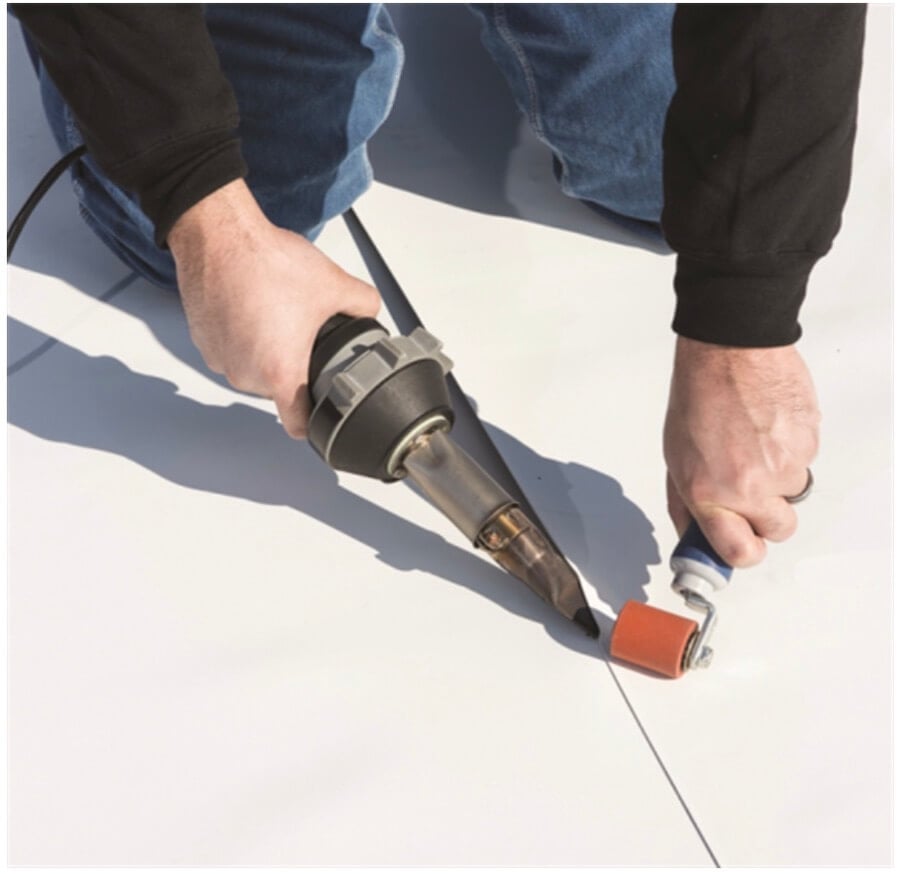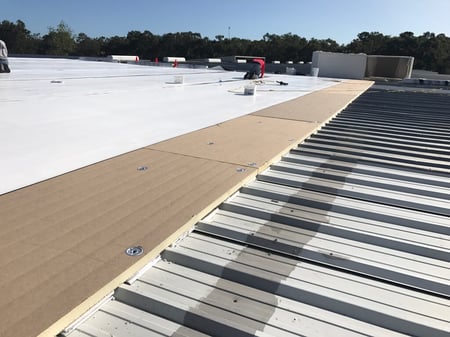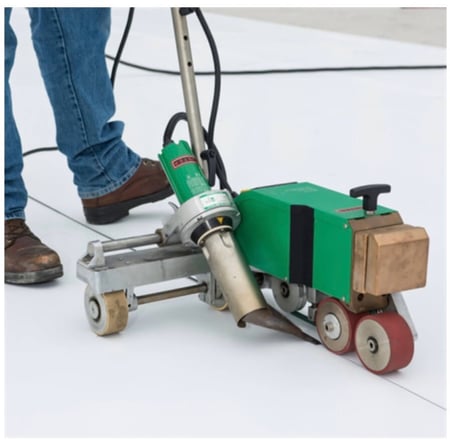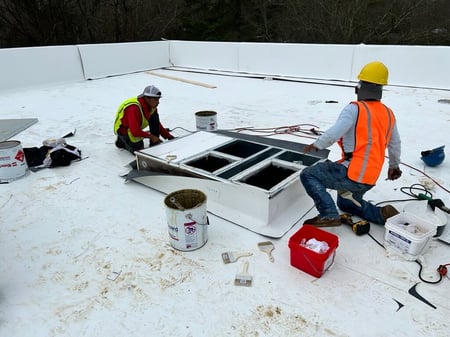
TPO retrofit roofing: Let’s talk about it! This contemporary and cost-effective solution has gained prominence in roofing systems over the years. TPO, or Thermoplastic Olefin, retrofit roofing involves the installation of a TPO membrane over an existing roof structure, presenting an awesome alternative to traditional full tear-off replacements.
At RoofCrafters, we can tell you that retrofit is, in fact, not referring to a really cool 70’s-style outfit (although, that would be pretty sweet), but instead an installation method where business owners alike can gain certain benefits such as increased durability, reflective properties, and ease of installation, which all contribute to its widespread adoption across commercial structures with flat or low-slope roofs.
That being said, as we delve into TPO retrofit roofing, we will explore its key benefits, applications, and considerations, shedding light on why this roofing solution has become a preferred and sustainable option in the landscape of building upgrades and improvements. Let’s get started!
What is TPO Retrofit Roofing?

TPO, also known as Thermoplastic Olefin retrofit roofing refers to the installation or replacement of a roofing system using TPO membrane on an existing roof structure. TPO is a single-ply roofing membrane that is known for its durability, energy efficiency, and ease of installation.
In a retrofit roofing scenario, the TPO membrane is typically installed over the existing roofing material without the need for complete removal. This can be a cost-effective solution for improving the performance and lifespan of a roof without undergoing a full tear-off process. Think of it like when it’s cold out, and instead of wearing one layer, you wear two! Your shirt or sweater keeps you warm, and your jacket protects you from the outer elements.
TPO retrofit roofing is commonly chosen for its reflective properties, which can contribute to energy efficiency by reducing the heat absorbed by the building. It is also known for being resistant to UV rays, chemicals, and punctures, making it a popular choice for commercial and industrial roofing applications.
Before considering a TPO retrofit roofing project, it's important to assess the condition of the existing roof and consult with roofing professionals to determine if it's a suitable option for the specific building and climate conditions. Sadly, sometimes your roof will need to undergo a complete tear-off and replacement, and retrofitting with TPO won’t always be the right choice for your building.
Where is TPO Retrofit Roofing Most Commonly Seen?

TPO retrofit roofing can be suitable for various types of buildings, particularly those with existing roofs that may need replacement or improvement. Here are 6 types of buildings for which TPO retrofit roofing is often considered a premier option:
Commercial buildings: TPO retrofit roofing is commonly used in commercial structures such as office buildings, retail spaces, shopping centers, and warehouses.
Industrial facilities: Manufacturing plants, warehouses, and other industrial spaces often benefit from TPO retrofit roofing due to its durability and resistance to chemicals.
Institutional buildings: TPO retrofit roofing can be suitable for institutional buildings like schools, hospitals, and government facilities.
Flat and low-slope roofs: TPO membranes are well-suited for flat and low-slope roofs, making them a popular choice for buildings with these roof designs.
Large roofing areas: Buildings with large roofing areas can benefit from TPO retrofit roofing, especially if cost-effectiveness and quick installation are priorities.
Energy-efficient projects: TPO is known for its reflective properties, which can contribute to energy efficiency. Therefore, buildings aiming for improved energy performance may choose TPO retrofit roofing.
It's important to note that the suitability of TPO retrofit roofing depends on various factors, including the condition of the existing roof, climate considerations, and specific building requirements. As always, consulting with your local roofing contractor is always going to be your best bet in assessing whether TPO retrofit roofing is the right choice for your particular building!
What Are the Benefits of TPO Retrofit Roofing?

TPO retrofit roofing offers several benefits, making it a popular choice for business owners looking to improve or replace their existing roofing systems. Here are some of the top 10 key benefits of TPO retrofit roofing:
Cost-effective installation: TPO retrofit roofing is often more cost-effective than a full roof replacement, as it can be installed over existing roofing materials, eliminating the need for a complete tear-off.
Durability: TPO membranes are known for their durability and resistance to various environmental factors. They can withstand UV rays, chemicals, and punctures, providing a long-lasting roofing solution.
Energy efficiency: TPO has reflective properties that help to reduce heat absorption by the building. This can contribute to improved energy efficiency and potentially lower cooling costs.
Lightweight: TPO is a lightweight roofing material, which can be beneficial for the structural integrity of the building. It puts less stress on the underlying structure compared to some other roofing materials.
Ease of installation: TPO membranes are often easier to install than some other roofing materials. The installation process is relatively quick, which can minimize disruptions to building operations.
Versatility: TPO retrofit roofing is suitable for various building types, including commercial, industrial, and institutional structures. It can be used on flat and low-slope roofs, offering versatility in design.
Resistance to mold and algae: TPO is resistant to mold and algae growth, contributing to a healthier indoor environment and reducing the need for frequent maintenance.
Recyclability: TPO is a recyclable material, making it an environmentally friendly option. Some TPO membranes can be recycled after their service life, reducing the environmental impact.
Weldable seams: TPO membranes are heat-weldable, creating strong and watertight seams. This enhances the overall waterproofing capability of the roofing system.
Warranty options: Many TPO manufacturers offer warranty options, providing building owners with added peace of mind regarding the performance and longevity of the roofing system.
Consider TPO Retrofit Roofing
TPO retrofit roofing can be a fabulous choice for business owners seeking a cost-effective and durable solution to enhance or replace their existing roofing systems. The benefits of TPO, such as its durability, energy efficiency, and ease of installation, make it a popular option for various building types, including commercial, industrial, and institutional structures with flat or low-slope roofs.
The cost-effectiveness of TPO retrofit roofing, achieved through its ability to be installed over existing materials without a full tear-off, can lead to significant savings. Additionally, TPO's reflective properties contribute to improved energy efficiency, potentially reducing cooling costs for building owners. Not to mention that many manufacturers offer warranty options, assuring business owners regarding the reliability of the roofing system.
As with any roofing decision, consulting with experienced professionals is crucial to assess the specific needs of the building, ensuring that TPO retrofit roofing is the right fit for both current requirements and long-term considerations. So, if you’re interested in TPO retrofit roofing for your commercial space, be sure to hit the “Schedule an Inspection” button down below, and one of our experts will walk you through your options!
My name is Cassie, and I’m the Content Manager here at RoofCrafters. I was born and raised in Chicago, Illinois, and made my way out to Florida post-college graduation. I’m incredibly passionate about writing and creating valuable content that helps others with the collaboration of my marketing team. When I’m not working, I enjoy shopping (a little too much), spending time at the beach, and reading!



